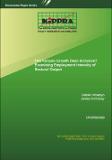| dc.description.abstract | Debate has emerged about inclusivity of Kenya’s economic growth with constant concerns on its ability to create adequate employment for the ever-increasing number of job seekers. While it is strongly believed that pro-employment growth is an efficient means for attaining inclusive growth, creation opportunities for decent jobs, reduction of poverty and income inequality remains one of Kenya’s key policy priority areas. Using a unique sector-level gross value added and employment data sets on the Kenyan economy over the period 1978-2017, we examine the employment intensity of Kenya’s sectoral output, specifically to ascertain which sectors are employment-intensive and thus job creating. Due to the perceived interrelationships among the sectors, we adopt the seemingly unrelated regression (SUR) model consisting of nine single equations. The model was fit using the SUR estimator. Empirical findings provide evidence that overall employment elasticity in the economy is inelastic and stood at 0.24 per cent, implying that for a one per cent increase in GDP, employment will increase by 0.24 per cent for the overall economy. Sectoral output elasticities, on the other hand, ranged from -0.04 per cent in the agriculture sector to 0.37 per cent in the trade and hospitality sector. Our study further provides evidence that sector-level output impacts on employment creation differently, thus some sectors are more inclusive than others. The sector that is more inclusive is trade and hospitality sector, followed by community and social services sector, then finance and business services sector, construction sector and transport sector. We find negative elasticity for the agriculture sector, implying that sectoral growth is mainly productivity driven. From our findings, it is important that the Government recognizes the sectoral difference in job creation and, therefore, tailor inclusive growth strategies in response to different sectoral employment elasticities of growth. This is critical in the Kenyan case given the dominance informal sector employment, mainly constituting small and medium enterprises. | en |

